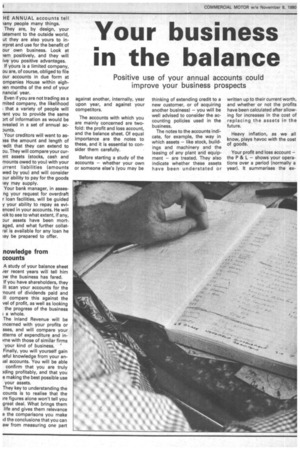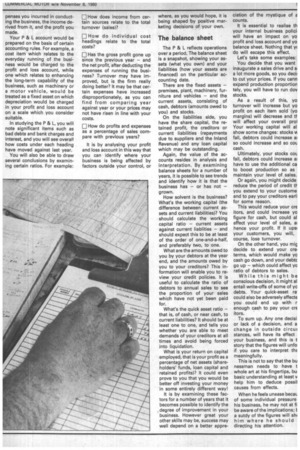Your business in the balance
Page 56

Page 57

If you've noticed an error in this article please click here to report it so we can fix it.
HE ANNUAL accounts tell lany people many things.
They are, by design, your tatement to the outside world, ut they are also yours to in3rpret and use for the benefit of our own business. Look at lem positively, and they will ive you positive advantages. If yours is a limited company, ou are, of course, obliged to file our accounts in due form at ompanies House within eigh:en months of the end of your nancial year.
Even if you are not trading as a mited company, the likelihood . that a variety of people will rant you to provide the same art of information as would be )vealed in a set of annual ac3unts.
Your creditors will want to asSs the amount and length of -edit that they can extend to ou. They will compare your cur3nt assets (stocks, cash and mounts owed to you) with your Jrrent liabilities (amounts wed by you) and will consider Du r ability to pay for the goods ley may supply.
Your bank manager, in assesng your request for overdraft r loan facilities, will be guided y your ability to repay as eyienced in your accounts. He will Kok to see to what extent, if any, our assets have been mort-. aged, and what further collet-al is available for any loan he lay be prepared to offer.
nowledge from ccounts
A study of your balance sheet rer recent years will tell him DW the business has fared.
If you have shareholders, they ill scan your accounts for the mount of dividends paid and ill compare this against the yel of profit, as well as looking the progress of the business ; a whole.
The Inland Revenue will be 3ncerned with your profits or sses, and will compare your itterns of expenditure and inme with those of similar firms your kind of business.
Finally, you will yourself gain ;eful knowledge from your anJai accounts. You will be able confirm that you are truly ]ding profitably, and that you e making the best possible use your assets.
They key to understanding the counts is to realise that the ire figures alone won't tell you great deal. What brings them life and gives them relevance e the comparisons you make Id the conclusions that you can aw from measuring one part against another, internally, year upon year, and against your competitors.
The accounts with which you are mainly concerned are twofold: the profit and loss account, and the balance sheet. Of equal importance are the notes to these, and it is essential to consider them carefully.
Before starting a study of the accounts — whether your own or someone else's (you may be thinking of extending credit to a new customer, or of acquiring another business) — you will be well advised to consider the accounting policies used in the business.
The notes to the accounts indicate, for example, the way in which assets — like stock, buildings and machinery and the leasing of any plant and equipment — are treated. They also indicate whether these assets have been understated or written up to their current worth, and whether or not the profits have been calculated after allowing for increases in the cost of replacing the assets in the future.
Heavy inflation, as we all know, plays havoc with the cost of goods.
Your profit and loss account — the P & L — shows your operations over a period (normally a year). It summarises the ex penses you incurred in conducting the business, the income derived from it, and the profit you made.
Your P & L account would be prepared on the basis of certain accounting rules. For example, a cost item which relates to the everyday running of the business would be charged to the profit and loss account, while one which relates to enhancing the long-term capability of the business, such as machinery or a motor vehicle, would be treated as a fixed asset on which depreciation would be charged in your profit and loss account on a scale which you consider suitable.
In studying the P & L, you will note significant items such as bad debts and bank charges and interest, and you will see overall how costs under each heading have moved against last year.
You will also be able to draw several conclusions by examining certain ratios. For example:
E How does income from certain sources relate to the total turnover (sales)?
LII How do individual cost headings relate to the total costs?
Has the gross profit gone up since the previous year — and the net profit, after deducting the expenses of running the business? Turnover may have improved, but is the firm really doing better? It may be that certain expenses have increased disproportionately, as you can find from comparing year against year or your prices may not have risen in line with your costs.
LI How do profits and expenses as a percentage of sales compare with previous years?
It is by analysing your profit and loss account in this way that you can identify where your business is being affected by factors outside your control, or where, as you would hope, it is being shaped by positive marketing decisions of your own.
The balance sheet
The P & L reflects operations over a period. The balance sheet is a snapshot, showing your assets (what you own) and your liabilities (how your assets are financed) on the particular accounting date.
There are the fixed assets — premises, plant, machinery, furniture and vehicles — and the current assets, consisting of cash, debtors (amounts owed to you) and stocks.
On the liabilities side, you have the share capital, the retained profit, the creditors or current liabilities (repayments due to suppliers and the Inland Revenue) and any loan capital which may be outstanding.
Again, the value of the accounts resides in analysis and interpretation. By examining balance sheets for a number of years, it is possible to see trends and identify how it is that the business has — or has not — grown.
How solvent is the business? What's the working capital (the difference between current as sets and current liabilities)? You should calculate the working capital ratio — current assets against current liablities — and should expect this to be at least of the order of one-and-a-half, and preferably two, to one.
What are the amounts owed to you by your debtors at the year end, and the amounts owed by you to your creditors? This information will enable you to re view your credit policies. It is useful to calculate the ratio of debtors to annual sales to see the proportion of your sales which have not yet been paid for.
What's the quick asset ratio — that is, of cash, or near cash, to current liabilities? It should be at least one to one, and tells you whether you are able to meet demands of your creditors at all times and avoid being forced into liquidation.
What is your return on capital employed, that is your profit as a percentage of net assets (share holders' funds, loan capital and retained profits)? It could even prove to you that you would be better off investing your money in some entirely different wayl It is by examining these factors for a number of years that it becomes possible to identify the degree of improvement in your business. However great your other skills may be, success may well depend on a better appre ciation of the mystique of a counts.
It is essential to realise th your internal business polici, will have an impact on yo profit and loss account and yo balance sheet. Nothing that yc do will escape this effect.
Let's take some examples: You decide that you want inaugurate a sales drive and si a lot more goods, so you decii to cut your prices. If you cann expand production proportion tely, you will have to run cloy stocks.
As a result of this, yo turnover will increase but yo profit on each item sold (yo margins) will decrease and tt will affect your overall proi Your working capital will al: show some changes: stocks v% fall, debtors could increase al so could increase and so cou cash.
Ultimately, your stocks cou fail, debtors could increase al have to use the additional ca to boost production so as maintain your level of sales.
Or again, you might decide reduce the period of credit th you extend to your custome and to pay your creditors earli for some reason.
This would reduce your cre itors, and could increase yo figure for cash, but could al affect your level of sales, al hence your profit. If it upsi your customers, you will, course, lose turnover.
On the other hand, you mic decide to extend your cre, terms, which would make yo cash go down, and your debtc go up — which could affect yo ratio of debtors to sales.
While this might be conscious decision, it might al entail write-offs of some of ye debts. Your quick-asset ra. could also be adversely affecte you could end up with r enough cash to pay your crE itors.
To sum up. Any one decisi or lack of a decision, and a change in outside circur stances, will have its effect your business, and this is t story that the figures will unfo if you care to interpret thE meaningfully.
This is not to say that the bu nessman needs to have t whole art at his fingertips, bu basic understanding at least v help him to deduce possil causes from effects.
When he feels unease becaL of some individual pressure his business, he may not at fi be aware of the implications; k a sutdy of the figures will she him where he should directing his attention.




















































































































